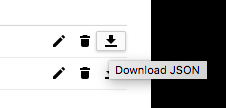ユーザー アカウントを使用してインストール済みのアプリを認証する
このガイドでは、アプリがユーザーのマシンにインストールされているときに、BigQuery API へのアクセスについてユーザー アカウントを使用して認証する方法を説明します。
エンドユーザーが使用できる BigQuery テーブルのみにアプリがアクセスするようにするには、ユーザー認証情報を使用して認証します。ユーザー認証情報でクエリを実行できるのは、エンドユーザーの Google Cloud プロジェクトに制限され、アプリケーションのプロジェクトに対しては実行できません。その結果、ユーザーはアプリではなくクエリに対して課金されます。
始める前に
- インストールされているアプリを表す Google Cloud プロジェクトを作成します。
- BigQuery クライアント ライブラリをインストールします。
-
認証ライブラリをインストールします。
Java
Maven を使用している場合は、pom ファイルに次の依存関係を含めます。
Python
Google Auth と統合された oauthlib をインストールします。
pip install --upgrade google-auth-oauthlib
Node.js
Google Auth と統合された oauthlib をインストールします。
npm install google-auth-library
npm install readline-promise
クライアント認証情報を設定する
次のボタンを使用してプロジェクトを選択し、必要な認証情報を作成します。認証情報を手動で作成する
- Google Cloud コンソールの [認証情報] ページに移動します。
- OAuth 同意画面の必須フィールドに必要事項を入力します。
- [認証情報] ページで、[認証情報を作成] ボタンをクリックします。
[OAuth クライアント ID] を選択します。
- アプリの種類として [デスクトップ] を選択し、[作成] をクリックします。
- [JSON をダウンロード] ボタンをクリックして、認証情報をダウンロードします。

認証情報ファイルを
client_secrets.jsonに保存します。このファイルはアプリとともに配布する必要があります。
API の認証と呼び出し
-
クライアント認証情報を使用して OAuth 2.0 フローを実行します。
Java
Python
Node.js
-
認証済みの認証情報を使用して BigQuery API に接続します。
Java
Python
Node.js
サンプルコードを実行すると、クライアント シークレットに関連付けられているプロジェクトへのアクセスを要求するブラウザが起動されます。サンプルで BigQuery スコープが要求されたため、生成された認証情報を使用してユーザーの BigQuery リソースにアクセスできます。
次のステップ
- アプリを認証して BigQuery API にアクセスするその他の方法について学びます。
- すべての Cloud APIs のエンドユーザー認証情報を使用した認証について学びます。
